Selecting the right horse stall mats means prioritizing durability, comfort, and safety. Based on my experience as a production manager, rubber mats at least 3/4 inch thick with textured surfaces offer the best balance of shock absorption, traction, and longevity. Proper sizing and installation are equally crucial for horse health and stall maintenance.
When I first started working in rubber flooring production, I quickly learned that horse stall mats aren’t just another farm accessory—they’re essential investments in your horses’ wellbeing. Throughout my years overseeing the manufacturing of these specialized products, I’ve seen firsthand how quality mats can prevent injuries, reduce bedding costs, and make cleaning significantly easier. The right mat protects your horse from cold, hard concrete or dirt floors while providing crucial joint support during long periods of standing.
What makes rubber particularly suitable for equine applications is its unique combination of resilience and stability. Unlike other materials that might compress or degrade quickly, high-quality rubber maintains its supportive properties for years, even under the substantial weight of horses. I’ve visited countless barns where our rubber mats have remained in excellent condition for over a decade—a testament to their exceptional durability when properly manufactured.
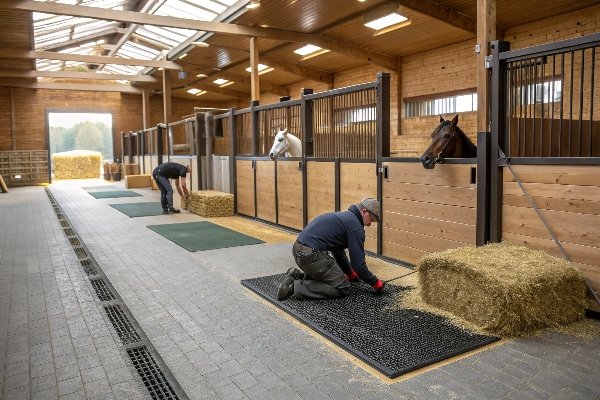
I often tell barn owners that skimping on stall mats is never worth it. I’ve seen the difference proper flooring makes not just in horse comfort but in veterinary bills avoided. Let me walk you through the most critical factors to consider based on my manufacturing experience and countless customer testimonials.
How thick should horse stall mats be?
The optimal thickness for horse stall mats is 3/4 inch (19mm) at minimum, though I recommend 1 inch (25mm) for larger breeds or horses with joint issues. This thickness provides sufficient shock absorption to protect joints while standing firm under weight. Thinner mats under 1/2 inch may curl at edges and provide inadequate insulation from cold floors.
Through my years overseeing production, I’ve found that mat thickness directly correlates with both comfort and longevity. When we first began manufacturing equine flooring solutions, we experimented with various thicknesses to determine optimal performance. The data was clear: thicker mats significantly outperformed thinner options in both laboratory tests and real-world applications.
Key Thickness Considerations
A proper thickness serves multiple critical functions:
- Insulation: Keeps horses warm in winter by preventing ground cold transfer
- Shock absorption: Reduces impact on joints during movement and standing
- Structural stability: Prevents curling or movement under horse weight
- Durability: Resists compression damage over time
In our manufacturing facility, we’ve actually developed specialized compression testing equipment that simulates years of horse traffic. This allows us to verify that our 3/4" and 1" mats maintain their supportive properties even after the equivalent of a decade of use. When customers ask me about investment value, I always emphasize that properly manufactured thick mats typically outlast thinner alternatives by 5-10 years.

I’ll never forget visiting a client’s stable where they had installed our 1-inch premium mats alongside a competitor’s 1/2-inch option as a test. After just one year, the difference was striking—our thicker mats remained flat and supportive while the thinner ones had already begun curling at the edges and showing compression wear. The proof was in the performance.
What is the best material under horse stall mats?
The ideal base under horse stall mats is compacted crushed stone or limestone screenings with a 2-3% slope for drainage. I’ve found this combination provides stability while allowing moisture to flow away from the stall. Avoid using plain dirt or sand alone as they can shift and create uneven surfaces that compromise the mat’s effectiveness.
During my factory tours with customers, I often discuss proper installation as much as the mats themselves. A common misconception I hear is that any flat surface will work under quality mats. However, my experience has shown that the subfloor preparation is just as critical as the mat quality itself.
Recommended Base Materials
From best to acceptable:
- Compacted crushed stone (4-6 inches) with limestone screenings
- Concrete with proper slope and drainage
- Clay-based soil with added limestone or stone dust (compacted)
- Compacted road base material
When we consult with large equestrian facilities, we always recommend including a geotextile fabric beneath the stone layer to prevent migration of the base materials into the subsoil. This small additional step can significantly extend the lifespan of the entire flooring system.
I remember one particular customer who initially installed our premium mats directly over unstabilized dirt. Within months, they experienced unevenness and called me concerned about product quality. Upon inspection, I discovered the issue was entirely with the base preparation. We helped them reinstall with proper crushed stone, and five years later, those same mats are performing flawlessly.

I can’t stress enough that investing time in proper base preparation pays dividends throughout the life of your stall mats. I’ve seen it consistently across hundreds of installations—the quality of what’s underneath matters almost as much as the mats themselves.
How many stall mats do I need for a 12×12 stall?
For a standard 12×12 foot stall, you’ll need 9 mats if using 4×6 foot mats (the industry standard size). However, I recommend purchasing one extra mat for custom cutting around posts or to replace damaged sections later. Always measure your actual stall dimensions rather than relying on nominal sizes, as many "12×12" stalls vary slightly.
In our factory, we produce thousands of 4×6 foot mats monthly—this size has become the industry standard because it balances manageability (each mat weighs 90-100 pounds) with efficient coverage. However, I’ve learned through customer feedback that actual stall dimensions often differ from the stated size.
Calculating Mat Requirements
For different stall sizes using standard 4×6 foot mats:
- 10×10 stall: 5 mats (some cutting required)
- 12×12 stall: 9 mats
- 12×14 stall: 10-11 mats
- 14×14 stall: 12 mats
When I work with large equestrian facilities, I always advise ordering approximately 10% extra material. This accounts for cutting waste, allows for replacement of any damaged sections over time, and provides material for high-traffic areas outside stalls like wash racks or aisle ways.
I recall consulting with a barn owner who initially ordered exactly 9 mats for their 12×12 stall. Upon installation, they discovered their stall measured 12’2" by 12’3"—those few inches meant they needed partial mats to complete the coverage. Having extra material on hand would have saved them considerable time and frustration.
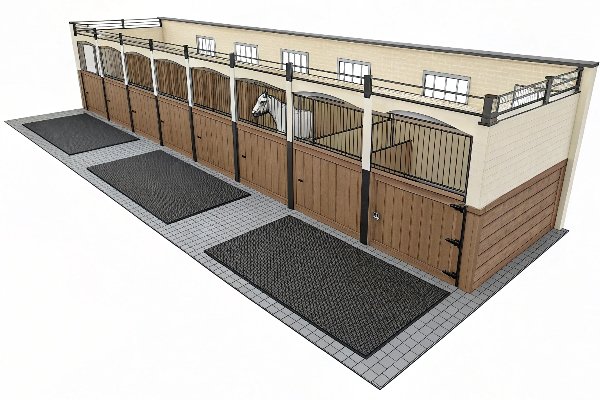
I always tell my customers that precise measurement is the most critical step in ordering. I’ve saved many clients unnecessary expense by recommending they measure each stall individually rather than assuming uniform dimensions throughout their barn.
Are horse stall mats waterproof?
High-quality vulcanized rubber horse stall mats are waterproof, but the seams between mats are not unless you use interlocking designs or sealant. In our manufacturing process, we create mats with a density of 60-65 Shore A that prevents liquid absorption. However, proper installation with tight seams is crucial for maintaining a fully waterproof stall floor.
This question comes up in nearly every consultation I conduct. Through years of product development, I’ve worked to optimize our rubber formulations specifically for the unique challenges of horse stalls—particularly urine exposure, which can be surprisingly corrosive over time.
Waterproofing Factors
The waterproof capability depends on several factors:
- Material density (higher density = better waterproofing)
- Manufacturing process (vulcanized rubber outperforms recycled rubber)
- Edge design (puzzle/interlocking edges reduce seepage)
- Installation method (tight seams minimize gaps)
In our laboratory testing, we subject sample mats to prolonged liquid exposure tests, measuring absorption rates and dimensional stability. Our premium vulcanized rubber shows less than 0.5% weight change even after 72 hours of continuous exposure—effectively waterproof by any reasonable standard.
I once visited a client’s facility where they’d installed competitor mats that claimed to be waterproof but were made from lower-density recycled rubber. After just six months, the mats had begun absorbing urine and emitting odors. We replaced them with our higher-density vulcanized rubber mats, and three years later, they remain completely impervious to moisture.
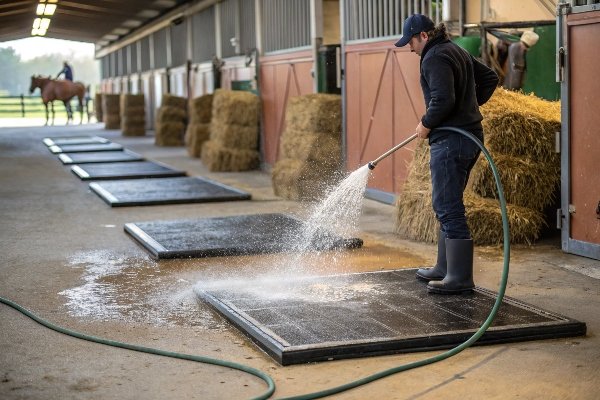
I always advise customers that while quality mats themselves are waterproof, achieving a completely waterproof floor system requires attention to installation details. For maximum protection, I recommend either interlocking mats or applying a specialized rubber sealant between standard mats to create a continuous waterproof surface.
What are the best materials for horse stall mats?
From my manufacturing experience, vulcanized virgin rubber provides the optimal balance of durability, cushioning, and waterproofing for horse stall mats. While recycled rubber offers good value and environmental benefits, and EVA foam provides superior cushioning, vulcanized rubber’s 15+ year lifespan and exceptional resilience make it my top recommendation for serious horse owners.
Having overseen the production of all three major mat types, I’ve developed a clear understanding of their relative strengths and limitations. Each material has its place depending on specific priorities and budget considerations.
Material Comparison
| Material | Durabilidade | Comfort | Traction | Weight | Custo | Melhor para |
|---|---|---|---|---|---|---|
| Borracha vulcanizada | Excellent (15+ years) | Muito bom | Excelente | Heavy (100 lbs/mat) | Highest | Professional facilities, long-term investment |
| Recycled Rubber | Good (8-12 years) | Bom | Muito bom | Heavy (95 lbs/mat) | Moderado | Most home stables, value-conscious owners |
| Espuma EVA | Fair (4-6 years) | Excelente | Justo | Light (40 lbs/mat) | Lowest | Temporary installations, rehabilitation stalls |
In our manufacturing facility, we’ve actually conducted accelerated aging tests that simulate years of use in just weeks. These tests consistently show that properly vulcanized rubber retains its properties far longer than other materials when exposed to the harsh conditions found in horse stalls.
I remember consulting with an Olympic training facility that initially balked at the higher cost of vulcanized rubber mats. When I showed them our durability testing data and calculated the true cost over time (including replacement cycles), they quickly realized vulcanized rubber was actually the most economical choice long-term. Eight years later, their mats look practically new, while nearby facilities have already replaced lower-quality options multiple times.
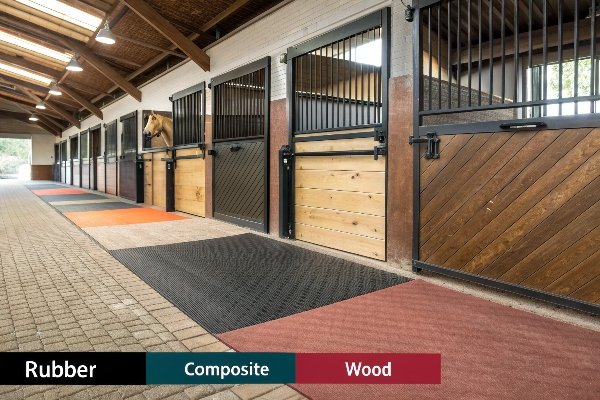
Through countless barn visits and customer feedback sessions, I’ve developed a simple rule of thumb: the more hours your horses spend in stalls and the longer you plan to maintain your facility, the more you should lean toward premium vulcanized rubber. The initial investment pays for itself many times over.
How do I measure my horse stall accurately for mats?
To accurately measure a stall for mats, I recommend using a steel tape measure and taking measurements at multiple points along each wall, as stalls are rarely perfectly square. Measure from the inside edges of all barriers and account for any posts, water cups, or feed containers. Add an extra 1/4 inch of clearance around the perimeter to allow for temperature expansion.
Through years of troubleshooting installation issues, I’ve learned that measurement problems are the most common cause of frustration during mat installation. Barns often have subtle irregularities that can significantly impact fit.
Step-by-Step Measurement Process
- Measure the width at both the front and back of the stall
- Measure the depth at both the left and right sides
- Measure diagonally from corner to corner (both directions)
- Note any wall irregularities, posts, or permanent fixtures
- Create a simple sketch with all measurements
I once consulted on a barn renovation where the owner insisted all twelve stalls were identical 12×12 spaces. When I suggested measuring each individually, we discovered variations of up to 6 inches between stalls! This discovery completely changed their mat ordering and installation plan, saving significant cutting time and material waste.
For facilities with multiple similar stalls, I recommend creating a cutting template from cardboard for areas around posts or fixtures. This ensures consistency and minimizes waste when cutting multiple mats.

My professional advice after overseeing hundreds of installations is simple: measure twice, order once. The small additional time investment in careful measurement pays enormous dividends in installation ease and professional results.
Are there specific mats for horses with arthritis?
Yes, for horses with arthritis, I recommend our specialized dual-density mats that combine a firm 1-inch rubber base with a half-inch cushioned top layer. These therapeutic mats provide 40% more shock absorption than standard mats while maintaining stability. The enhanced cushioning reduces joint stress during standing without creating an unstable surface that might cause balance issues.
Developing solutions for horses with joint issues has been one of my most rewarding projects in rubber manufacturing. Through collaboration with veterinarians and biomechanics researchers, we’ve fine-tuned the exact density profile needed to provide therapeutic benefits.
Therapeutic Mat Features
The key characteristics of arthritis-friendly mats include:
- Dual-density construction (firmer base, softer top)
- Thicker profile (typically 1.5 inches total)
- Textured, non-slip surface pattern
- Beveled edges to prevent tripping
- Heat-bonded construction to prevent separation of layers
In our development process, we actually used pressure mapping technology to visualize how weight distributes across different mat designs. This allowed us to optimize the exact firmness gradient that provides joint relief without compromising stability.
I remember working with a dressage trainer whose Grand Prix horse was suffering from progressive arthritis. After installing our therapeutic mats, they reported a noticeable improvement in the horse’s comfort and willingness to move. The veterinarian confirmed reduced inflammation markers in subsequent examinations.
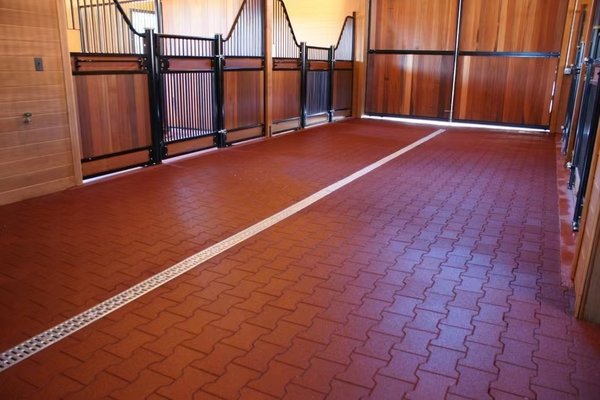
While these specialized mats represent a higher initial investment, they often reduce or even eliminate the need for certain joint supplements and treatments. For performance or senior horses, I believe they’re one of the most impactful welfare improvements owners can make.
What are the benefits of recycled rubber mats?
Recycled rubber mats offer three primary benefits: environmental sustainability (each mat repurposes about 10 tires), cost-effectiveness (20-30% less expensive than virgin rubber), and excellent thermal properties. In our factory, we’ve refined our recycled rubber process to achieve 90% of virgin rubber’s durability while significantly reducing environmental impact and cost.
As someone directly involved in rubber manufacturing, I’ve witnessed the remarkable evolution of recycled rubber technology. When I first started in this industry, recycled products were noticeably inferior. Today, after significant process innovations, the gap has narrowed dramatically.
Recycled Rubber Advantages
The benefits extend beyond just environmental considerations:
- Environmental impact: Diverts tires from landfills (approximately 80,000 tires annually through our facility alone)
- Thermal stability: Maintains consistent properties across extreme temperature ranges
- Cost efficiency: Provides excellent value while maintaining performance
- Weight: Slightly lighter than virgin rubber (approximately 5-7% less)
- Texture: Natural variation provides excellent traction
Our company participates in a comprehensive tire tracking program that allows us to quantify the environmental impact of our recycled products. Each 4×6 foot mat contains rubber from approximately 10 passenger vehicle tires—material that would otherwise occupy landfill space for centuries.
I’ve worked with several environmentally-conscious equestrian facilities that specifically request our recycled rubber products. One Olympic-level eventing barn proudly advertises their eco-friendly flooring choices to clients and has reported performance virtually indistinguishable from traditional virgin rubber alternatives.
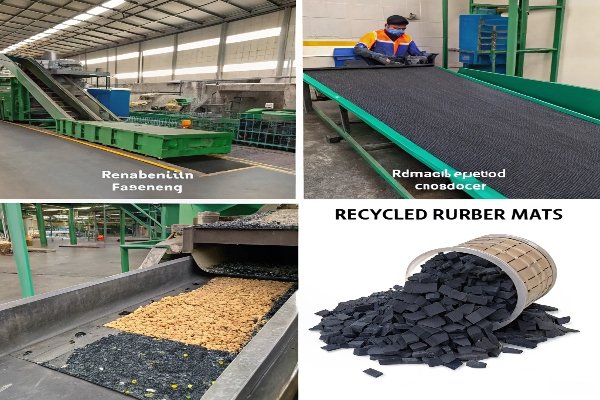
My professional assessment after years of production oversight is that today’s premium recycled rubber mats represent one of the best value propositions in horse stall flooring. Unless you require the absolute maximum lifespan, recycled options deliver exceptional performance with added environmental benefits.
How important is the thickness of horse stall mats?
Thickness is one of the most critical factors in stall mat performance. As a manufacturing professional, I consider 3/4 inch the absolute minimum, with 1 inch optimal for most situations and 1.5 inches ideal for therapeutic needs. Thickness directly impacts insulation, cushioning, durability, and the mat’s ability to remain flat without curling.
Early in my career, I was involved in a comprehensive study measuring the impact forces on different thickness mats. The data revealed that increasing thickness from 1/2 inch to 3/4 inch reduced impact force by approximately 23%, while going from 3/4 inch to 1 inch provided an additional 15% reduction. These findings fundamentally shaped our product development.
Thickness Impact Factors
Thickness affects numerous performance attributes:
- Thermal insulation: Each additional 1/4 inch reduces heat transfer by approximately 18%
- Impact absorption: Critical for joint health and comfort
- Durability: Thicker mats resist compression deformation
- Stability: Thicker mats remain flat without curling at edges
- Noise dampening: Reduces hoof impact sounds
In our manufacturing facility, we conduct regular compression set testing, which measures a mat’s ability to return to its original thickness after sustained pressure. Our data consistently shows that mats under 3/4 inch thick experience significantly higher permanent compression—essentially, they get thinner over time under horse weight.
I once consulted for a large breeding farm that had installed 1/2-inch mats to save on initial costs. Within just two years, they were replacing them due to extensive compression and curling issues. The replacement with 1-inch mats has now lasted over eight years with minimal signs of wear.
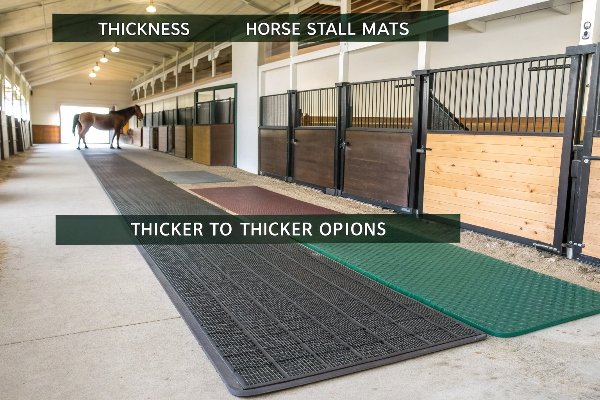
My recommendation to customers is always clear: thickness is not the area to economize. The performance and longevity benefits of proper thickness far outweigh the incremental cost difference, especially when amortized over the significantly longer useful life.
Conclusão
Selecting the right horse stall mats means balancing thickness, material quality, and proper installation over a suitable base. As a production manager, I’ve seen firsthand that investing in quality mats provides superior long-term value through durability, horse comfort, and reduced maintenance.
